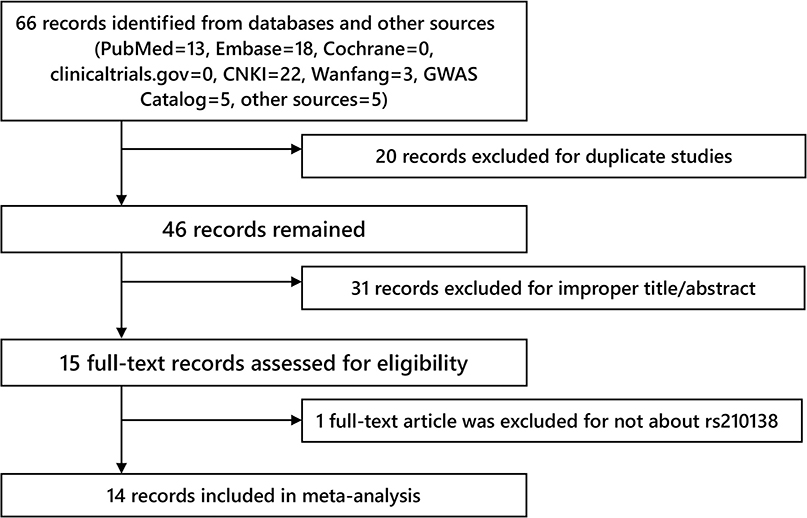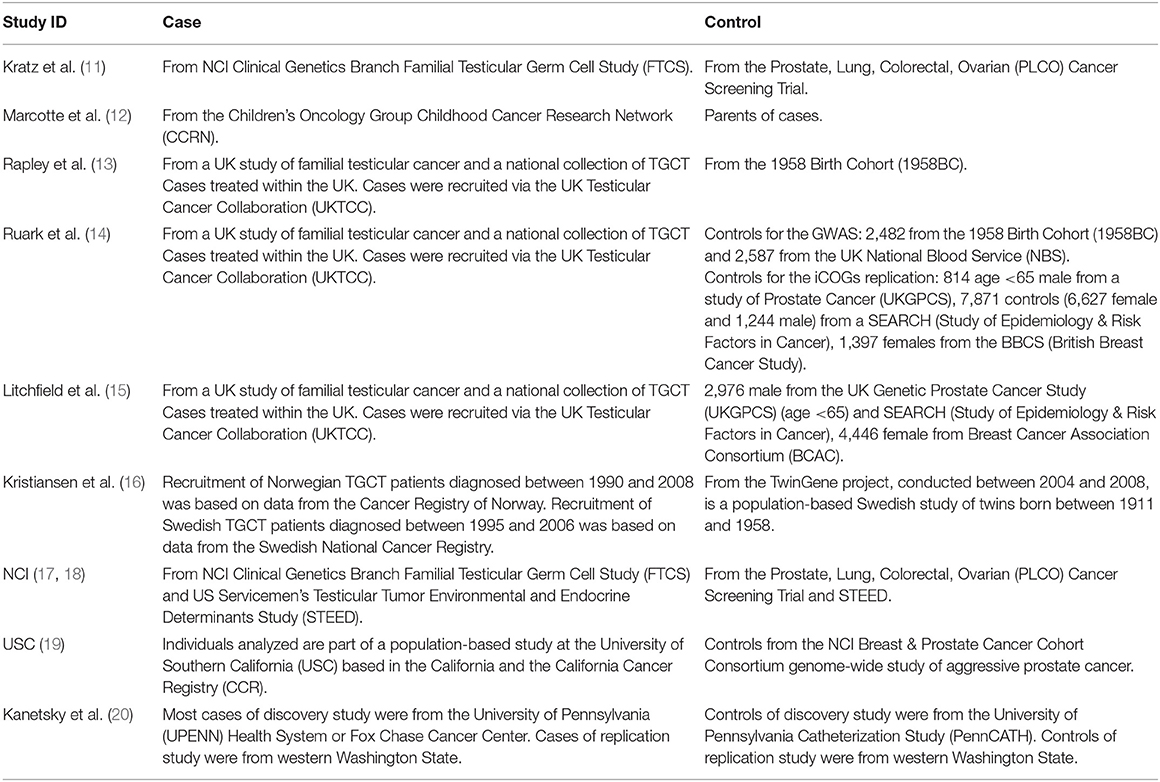- 1Department of Urology Surgery, The First Affiliated Hospital of Xiamen University, Xiamen, China
- 2Center of Diagnosis and Treatment of Urinary System Diseases, The First Affiliated Hospital of Xiamen University, Xiamen, China
- 3The Key Laboratory of Urinary Tract Tumors and Calculi of Xiamen City, The First Affiliated Hospital of Xiamen University, Xiamen, China
Background: Several studies including some genome-wide association studies (GWAS) had shown that BAK1 gene rs210138 polymorphisms might be associated with testicular germ cell tumors (TGCT). Here we tried to sum up the association through a systematic review and meta-analysis.
Methods: Studies associated with BAK1 rs210138 and TGCT was systematically searched in databases. The effect size was pooled according to ORs and 95% CIs.
Results: Our systematic review and meta-analysis comprised 14 articles. Significantly increased risk of TGCT was found in eligible GWAS and follow-up studies, in overall group and its Caucasian subgroup.
Conclusions: Compared with adenine (A), BAK1 rs210138 guanine (G) is associated with increased risk of TGCT. Well-planned studies with larger sample size and more subgroups are needed to verify the risk identified in our systematic review and meta-analysis.
Background
More than 90% of cancers of the testicle develop in germ cells. Testicular germ cell tumor (TGCT) manly consist of seminomas and non-seminomas (1). The protein encoded by BCL2 antagonist/killer 1 (BAK1) gene belongs to the BCL2 protein family. BAK1 protein localizes to mitochondria, and functions to promote apoptosis. In a kind of Bak(−/−) mice, 60% mice harbored high-grade tumors within the testis (2). Several studies including some genome-wide association studies (GWAS) (3) had shown that BAK1 gene rs210138 polymorphisms might be associated with TGCT. Here we tried to sum up the association through a systematic review and meta-analysis.
Methods
Identification of Eligible Studies
Independently, two researchers systematically searched these databases: GWAS Catalog, Wanfang, CNKI, clinicaltrials.gov, Cochrane Library, PubMed, Embase. Term “rs210138” was used in GWAS Catalog. And in other databases, these terms were used without limitation: “BAK1” AND “cancer of testis OR carcinoma of testis OR testicular cancer OR testis cancer OR ball cancer OR testicular germ cell tumors OR TGCT” AND “polymorphisms OR polymorphism.” The last search update was on Nov 30, 2018. For additional studies, we made a manual search in reviews and references of related studies.
Inclusion and Exclusion Criteria
Independently, two researchers made the selection according to the following inclusion criteria: (1) evaluation of the association between BAK1 rs210138 and TGCT susceptibility; (2) case-control study; (3) studies focusing on tissues of human beings; (4) elaborate genotype data in non-GWAS study or enough data in GWAS study could be acquired. Exclusion criteria: (1) duplication of previous publications (When there were multiple publications from the same population, only the largest study was included); (2) review, comment, and editorial; (3) study without enough data; (4) studies focusing on cell lines. Dissertation thesis were included in the analysis. We took experience and inspiration from the article we have published recently (4), in which the inclusion and exclusion criteria was mature and rigorous.
Data Extraction
Data of the eligible studies were extracted by two investigators independently. Conflict was solved by discussion. The third investigator would be involved if necessary. Try to get detailed genotype data by contacting the author.
The following contents were collected: year of publication, the characteristics of cases and controls, first author's surname, ethnicity, Hardy-Weinberg equilibrium, source of control groups, country of origin, genotyping method, number of cases, and controls.
Methodological Quality Assessment
According to Newcastle-Ottawa Scale (NOS) (5), two investigators evaluated qualities of included studies independently. Quality scores range from 0 to 10, and higher scores means better quality of the study. The most important factor was “age, gender, and country.” Conflict was solved by discussion.
Statistics Analysis
This meta-analysis complied with the PRISMA checklists (6). Pooled ORs and 95% CIs were calculated to evaluate the strength of the association between BAK1 gene rs210138 polymorphisms and TGCT susceptibility. Evaluation of Hardy-Weinberg equilibrium (HWE), OR and 95% CIs, heterogeneity, sensitivity, and publication bias were performed according to methods in our published article (4). In addition, I–V random effects model was used in total to get all data shown in Table 4 except overall subgroup. Sensitivity analyses and potential publication bias were not performed in Table 4. Stata 12.0 software (StataCorp, College Station, Texas, USA) were used in all statistical analyses. We regarded two-tailed P < 0.05 as significant except for specified conditions, where a certain P-value was declared.
Results
Characteristics of Studies
In total, we captured 66 articles from databases (PubMed = 13, Embase = 18, Cochrane = 0, clinicaltrials.gov = 0, CNKI = 22, Wanfang = 3, GWAS Catalog = 5, other sources = 5). Figure 1 displayed the selection process. One full-text article was excluded for not about rs210138. Finally, 14 records (7–20) were included in our systematic review and meta-analysis. Tables 1, 2 displayed characteristics of each study. The control group of study Poynter et al. (7) and Dantsev et al. (10) had shown significant departure from HWE.
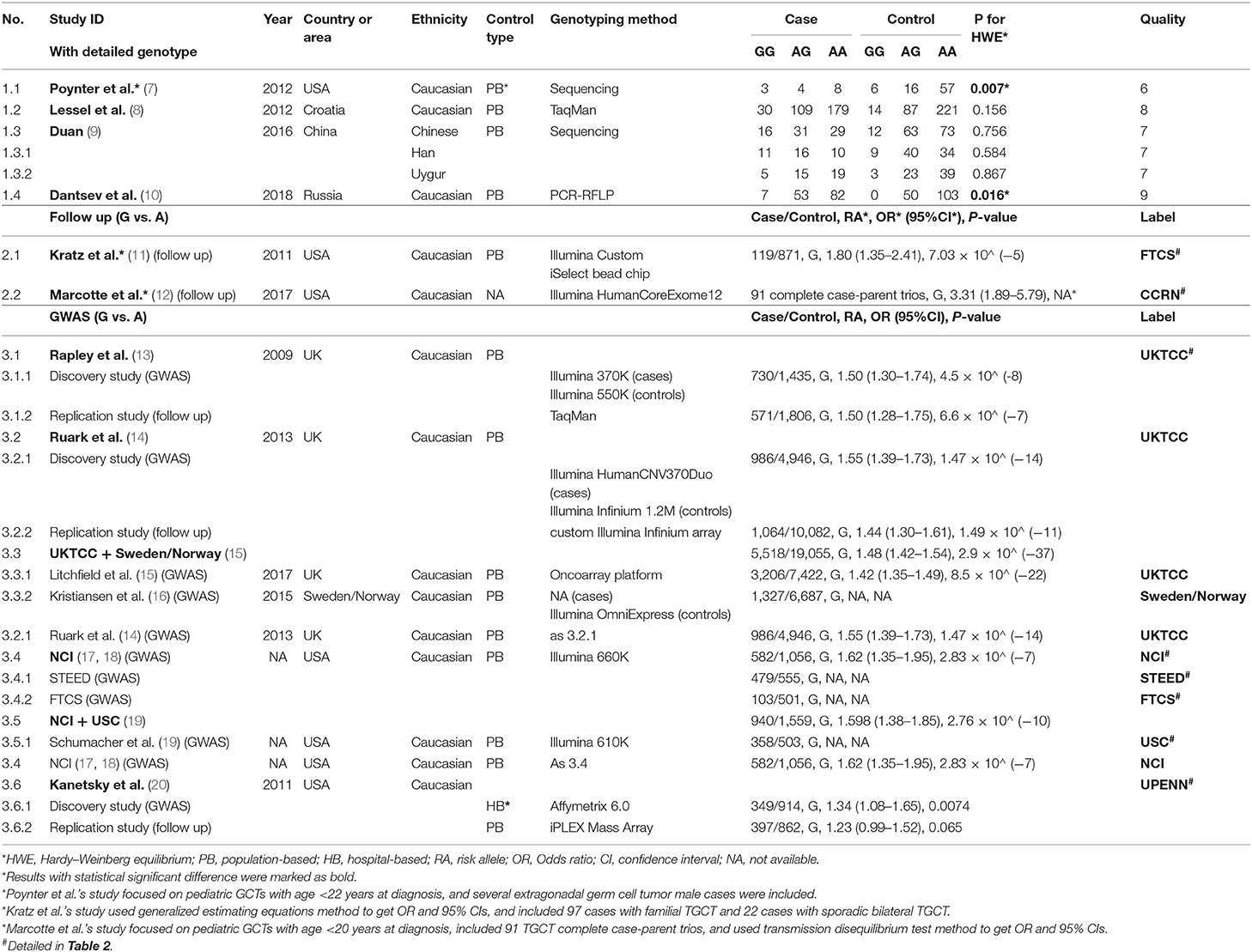
Table 1. Characteristics of studies about BAK1 rs210138 included in the systematic review and meta-analysis.
Meta-Analysis Overall
In overall group and its Caucasian subgroup, significantly increased risk of TGCT was found in all genetic models of BAK1 rs210138 (Table 3 and Figure 2). And the results showed stability in sensitivity analyses in four genetic models (Table 3). In heterozygote comparison (AG vs. AA), when study NO 1.2 was excluded, statistically different results were obtained (Table 3). No significant publication bias was found in Egger's test or Begg's test in either genetic models of overall group. Publication bias was not performed in Caucasian subgroup because of scanty data.
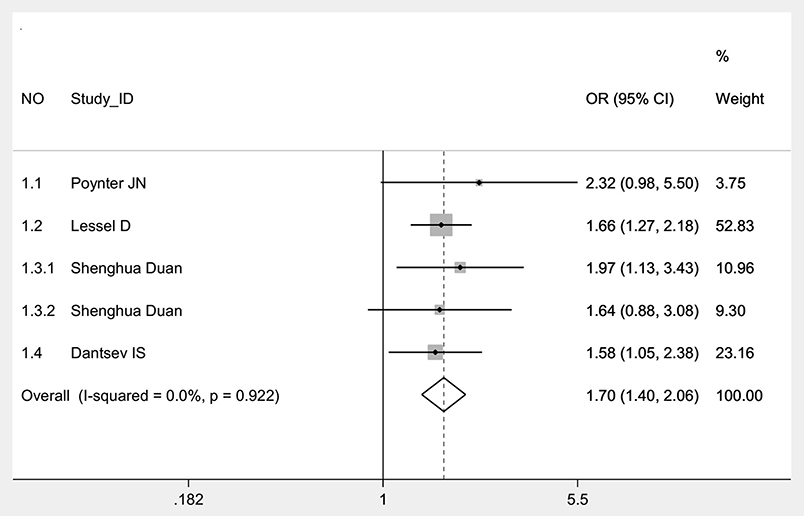
Figure 2. Forest plot with a fixed effects model for the association between BAK1 rs210138 and TGCT in allelic comparison (G vs. A) overall. For each study, the estimate of OR and its 95% CI is plotted with a box and a horizontal line. Rhombus: pooled OR and its 95% CI.
Meta-Analysis in Total
In our eligible GWAS and follow-up studies, we could not retrieve elaborate genotype data. Without elaborate genotype data, sensitivity analyses and potential publication bias were not performed. We tried to perform a meta-analysis based on OR and 95% CIs by using Stata 12.0 software in allelic comparison (G vs. A) (Figure 3), and I–V random effects model was used to get all data shown in Table 4 except overall group. Significantly increased risk of TGCT was found in all groups in Table 4.
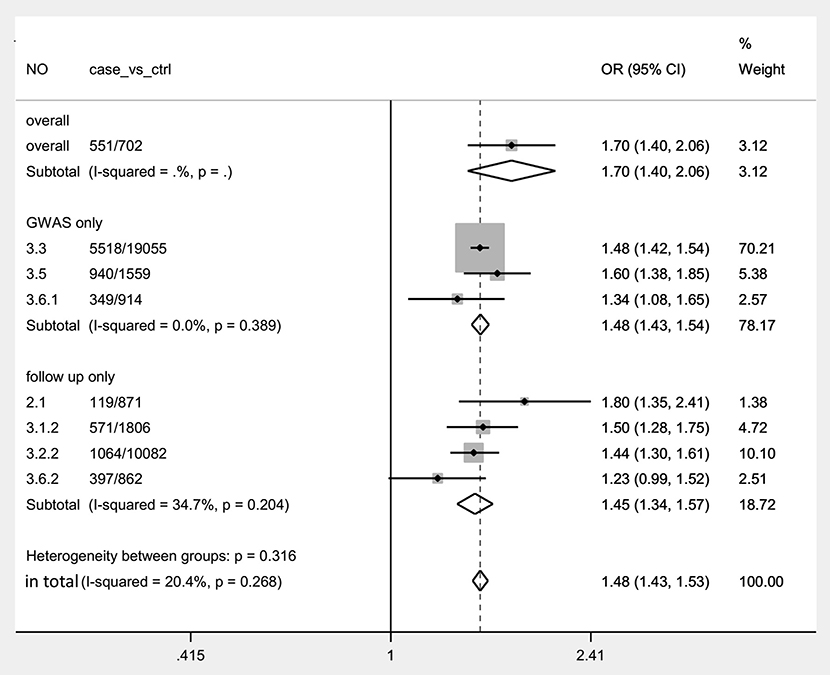
Figure 3. Forest plot with an I–V random effects model for the association between BAK1 rs210138 and TGCT in allelic comparison (G vs. A) in total. For each study, the estimate of OR and its 95% CI is plotted with a box and a horizontal line. Rhombus: pooled OR and its 95% CI.
Discussion
Above all, we found BAK1 rs210138 guanine (G) was associated with increased risk of TGCT in most genetic models in the meta-analysis of single case-control studies. In GWAS studies, follow-up studies and their meta-analysis based on OR and 95% CIs, BAK1 rs210138 guanine (G) also showed association with increased risk of TGCT in allelic comparison, which was consistent with the results in the meta-analysis of single case-control studies.
Meanwhile, our meta-analysis had several limitations which should be mentioned. Up to now, number of eligible studies for our meta-analysis were small. There was inadequate data for subgroup analyses. Omission of studies in other languages or unpublished studies might happened. In our eligible GWAS and follow-up studies, we could not retrieve elaborate genotype data. With those limitations, the study provided some insights on the potential association between BAK1 rs210138 and TGCT susceptibility.
Conclusion
Our results suggested that: Compared with adenine (A), BAK1 rs210138 guanine (G) is associated with increased risk of TGCT. Well-planned studies with larger sample size and more subgroups are needed to verify the risk identified in our systematic review and meta-analysis.
Ethics Statement
The Ethics Committee of the First Affiliated Hospital of Xiamen University approved the study protocol. Written informed consent was obtained from all patients enrolled in the investigation.
Author Contributions
JQ and JX designed the study, drafted and substantively revised the manuscript, and proof the English language. JQ, YY, and XZ accumulated the data. JQ and YY were for analysis and interpretation of the data. All authors read and approved the final manuscript.
Funding
The Science Fund founded by the First Affiliated Hospital of Xiamen University for Young Scholars (Project Number: XYY2016011; Recipient: JQ) and Youth Research Project of Fujian Provincial Health Commission (Project Number: 2019-2-47; Recipient: JQ).
Conflict of Interest
The authors declare that the research was conducted in the absence of any commercial or financial relationships that could be construed as a potential conflict of interest.
Acknowledgments
Recently, we (JQ and JX) have published another meta-analysis paper titled Association between CD40 rs1883832 and immune-related diseases susceptibility: A meta-analysis (4). The published paper has no relationship with this manuscript. The published paper and this manuscript used the same statistical method called meta-analysis to study two totally different scientific questions. Owing to the strict report specification (we used PRISMA in both study) of meta-analysis and the first author's writing habits (JQ), similarity could be found in several sections between the published paper and this manuscript, which needs to be acknowledged here.
Abbreviations
CNKI, China National Knowledge Infrastructure; CI, confidence intervals; GWAS, genome-wide association studies; HWE, Hardy-Weinberg equilibrium; NOS, Newcastle-Ottawa Scale; OR, odds ratio; TGCT, testicular germ cell tumors.
References
1. American Cancer Society. Available online at: http://www.cancer.org/cancer/testicularcancer/index (accessed November 17, 2018).
2. Katz SG, Fisher JK, Correll M, Bronson RT, Ligon KL, Walensky LD. Brain and testicular tumors in mice with progenitor cells lacking BAX and BAK. Oncogene. (2013) 32:4078–85. doi: 10.1038/onc.2012.421
3. Litchfield K, Shipley J, Turnbull C. Common variants identified in genome-wide association studies of testicular germ cell tumour: an update, biological insights and clinical application. Andrology. (2015) 3:34–46. doi: 10.1111/andr.304
4. Qin J, Xing J, Liu R, Chen B, Chen Y, Zhuang X. Association between CD40 rs1883832 and immune-related diseases susceptibility: a meta-analysis. Oncotarget. (2017) 8:102235–43. doi: 10.18632/oncotarget.18704
5. Wells GA, Shea B, O'Connell D, Peterson J, Welch V, Losos M, et al. The Newcastle-Ottawa Scale (NOS) for Assessing the Quality of Nonrandomised Studies in Meta-Analyses. Available online at: http://www.ohri.ca/programs/clinical_epidemiology/nosgen.pdf (accessed June 21, 2017).
6. Moher D, Liberati A, Tetzlaff J, Altman DG, PRISMA Group. Preferred reporting items for systematic reviews and meta-analyses: the PRISMA statement. J Clin Epidemiol. (2009) 62:1006–12. doi: 10.1016/j.jclinepi.2009.06.005
7. Poynter JN, Hooten AJ, Frazier AL, Ross JA. Associations between variants in KITLG, SPRY4, BAK1, and DMRT1 and pediatric germ cell tumors. Genes Chromosomes Cancer. (2012) 51:266–71. doi: 10.1002/gcc.20951
8. Lessel D, Gamulin M, Kulis T, Toliat MR, Grgic M, Friedrich K, et al. Replication of genetic susceptibility loci for testicular germ cell cancer in the Croatian population. Carcinogenesis. (2012) 33:1548–52. doi: 10.1093/carcin/bgs218
9. Duan S. Susceptibility Study of 9 Single Nucleotide Polymorphisms and Testicular Germ Cell Tumors (dissertation). Xinjiang Medical University, Ürümqi, China (2016).
10. Dantsev IS, Ivkin EV, Tryakin AA, Godlevski DN, Latyshev OY, Rudenko VV, et al. Asian J Androl. (2018) 20:593–9. doi: 10.4103/aja.aja_54_18
11. Kratz CP, Han SS, Rosenberg PS, Berndt SI, Burdett L, Yeager M, et al. Variants in or near KITLG, BAK1, DMRT1, and TERT-CLPTM1L predispose to familial testicular germ cell tumour. J Med Genet. (2011) 48:473–6. doi: 10.1136/jmedgenet-2011-100001
12. Marcotte EL, Pankratz N, Amatruda JF, Frazier AL, Krailo M, Davies S, et al. Variants in BAK1, SPRY4, and GAB2 are associated with pediatric germ cell tumors: a report from the children's oncology group. Genes Chromosomes Cancer. (2017) 56:548–58. doi: 10.1002/gcc.22457
13. Rapley EA, Turnbull C, Al Olama AA, Dermitzakis ET, Linger R, Huddart RA, et al. A genome-wide association study of testicular germ cell tumor. Nat Genet. (2009) 41:807–10. doi: 10.1038/ng.394
14. Ruark E, Seal S, McDonald H, Zhang F, Elliot A, Lau K, et al. Identification of nine new susceptibility loci for testicular cancer, including variants near DAZL and PRDM14. Nat Genet. (2013) 45:686–9. doi: 10.1038/ng.2635
15. Litchfield K, Levy M, Orlando G, Loveday C, Law PJ, Migliorini G, et al. Identification of 19 new risk loci and potential regulatory mechanisms influencing susceptibility to testicular germ cell tumor. Nat Genet. (2017) 49:1133–40. doi: 10.1038/ng.3896
16. Kristiansen W, Karlsson R, Rounge TB, Whitington T, Andreassen BK, Magnusson PK, et al. Two new loci and gene sets related to sex determination and cancer progression are associated with susceptibility to testicular germ cell tumor. Hum Mol Genet. (2015) 24:4138–46. doi: 10.1093/hmg/ddv129
17. Chung CC, Kanetsky PA, Wang Z, Hildebrandt MA, Koster R, Skotheim RI, et al. Meta-analysis identifies four new loci associated with testicular germ cell tumor. Nat Genet. (2013) 45:680–5. doi: 10.1038/ng.2634
18. Wang Z, McGlynn KA, Rajpert-De Meyts E, Bishop DT, Chung CC, Dalgaard MD, et al. Meta-analysis of five genome-wide association studies identifies multiple new loci associated with testicular germ cell tumor. Nat Genet. (2017) 49:1141–7. doi: 10.1038/ng.3879
19. Schumacher FR, Wang Z, Skotheim RI, Koster R, Chung CC, Hildebrandt MA, et al. Testicular germ cell tumor susceptibility associated with the UCK2 locus on chromosome 1q23. Hum Mol Genet. (2013) 22:2748–53. doi: 10.1093/hmg/ddt109
Keywords: BAK1, rs210138, single nucleotide polymorphisms, testicular germ cell tumors, meta-analysis
Citation: Qin J, Yang Y, Zhuang X and Xing J (2020) Association Between BAK1 Gene rs210138 Polymorphisms and Testicular Germ Cell Tumors: A Systematic Review and Meta-Analysis. Front. Endocrinol. 11:2. doi: 10.3389/fendo.2020.00002
Received: 05 November 2019; Accepted: 06 January 2020;
Published: 23 January 2020.
Edited by:
Andrea Garolla, University of Padova, ItalyReviewed by:
Marco Ghezzi, Independent Researcher, Padova, ItalyGiovanni Luca, University of Perugia, Italy
Copyright © 2020 Qin, Yang, Zhuang and Xing. This is an open-access article distributed under the terms of the Creative Commons Attribution License (CC BY). The use, distribution or reproduction in other forums is permitted, provided the original author(s) and the copyright owner(s) are credited and that the original publication in this journal is cited, in accordance with accepted academic practice. No use, distribution or reproduction is permitted which does not comply with these terms.
*Correspondence: Jiaxuan Qin, amlheHVhbnFpbkAxNjMuY29t; Jinchun Xing, amluY2h1bl94aW5nQDE2My5jb20=
 Jiaxuan Qin1,2,3*
Jiaxuan Qin1,2,3* Jinchun Xing
Jinchun Xing